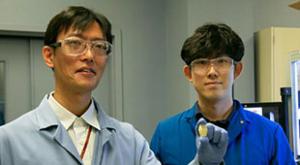All Features

Matthew Inniger
The inability to gather good data has challenged many food manufacturers for decades. But not anymore. As sensor technology has improved, and technology platforms have become more accessible and affordable to small and medium-sized manufacturers, the food industry is poised for transformation. Food…

Ula Chrobak
Thirty miles east of Reno, Nevada, past dusty hills patched with muted blue sage and the occasional injury-lawyer billboard, a large concrete structure rises prominently in the desert landscape. When fully constructed, it will be a pilot for a business that entrepreneurs envision as a major facet…

Kevin Kanimyar
Amidst the rise of conscious consumerism, corporate social responsibility (CSR) programs are fast becoming an essential part of any business. With about $20 billion spent every year by Fortune 500 companies alone, businesses around the world are working to integrate CSR programs into their business…

Jennifer Lauren Lee
As mechanical objects, gears have been around for so long that people generally take them for granted. But gears are sophisticated parts that play a vital role in cars, airplanes, construction and mining equipment, food processing, clock making, and more. Companies are still trying to make them…

Abdul Salam
Water is the most essential resource for life, for both humans and the crops we consume. Around the world, agriculture accounts for 70 percent of all freshwater use.
I study computers and information technology in the Purdue Polytechnic Institute, and direct Purdue’s Environmental Networking…

Seb Murray
In 1924, a cartel of light bulb manufacturers including General Electric and Philips agreed to artificially limit the lifespan of their products to about 1,000 hours—down from 2,500. The scandal, revealed decades later, came to epitomize the linear consumption model of making, consuming, and then…

Sarah Murray
John Foye remembers what sparked his passion for finding solutions to climate change. Backpacking in Utah’s Uinta Mountains with high school friends one day, they came across a patch of forest that had been clear-cut. While deforestation was not a problem in Utah, the sight of an area almost…

Quality Digest
One question led the founders of Nemo’s Garden, a subsea farming platform, to embark on its mission to take agriculture beneath the waves and bring better harvests to market: “Seventy percent of the planet is covered by water. Why don't we try to use part of the ocean to make more food, in a better…

Otto de Graaf
Despite the urgency of the climate crisis, and smart tech that enables the transition toward the factory of the future, for many manufacturers sustainability still feels like an afterthought rather than a priority. Certainly, sustainability may require big changes in strategy, processes, technology…

Anisur Rahman, Arif Arifuzzaman, Edgar Lara-Curzio, Tomonori Saito, Sungjin Kim
Researchers at the U.S. Dept. of Energy’s Oak Ridge National Laboratory (ONRL) have developed an upcycling approach that adds value to discarded plastics for reuse in additive manufacturing, or 3D printing. The readily adoptable, scalable method introduces a closed-loop strategy that could globally…

Rick Gould
As the world enters the third year of the Covid-19 pandemic, the climate crisis remains the biggest long-term threat facing humanity, according to the Global Risks Report 2022. Extreme weather due to climate change is seen as the second most serious short-term risk, with biodiversity loss coming in…

Luk Van Wassenhove
Labels such as “sustainable,” “eco-friendly,” and “green” have long been an easy sell. “Circular economy” joined their ranks when it debuted on the world stage at the World Economic Forum 2012. Even though related concepts have been discussed as early as in the 1970s, claims by the consulting world…

Emily Newton
There’s no better time than now. As a species, we need to mitigate the effect we have on our planet. There are many ways to do this—namely, through green and eco-friendly initiatives—but one sector is having the biggest impact of all: the industrial and manufacturing sector. In the 2010s, the…

Nicholas P. Sullivan
People in the world’s developed nations live in a post-industrial era, working mainly in service or knowledge industries. Manufacturers increasingly rely on sensors, robots, artificial intelligence, and machine learning to replace human labor or make it more efficient. Farmers can monitor crop…

Jonathan Gilpin
Regardless of how much we, as a society, are able to implement and use technologies in business, global supply chains will always be dependent on the ways in which people interact with one another.
Even local supply chains can be problematic, but it’s predominantly global ones that can pose…

Marc Lepere
As the war in Ukraine rages, finance professionals on Wall Street and in Europe recently attracted outrage by suggesting that investing in arms manufacturers should be treated as ethical investing. In the fight against tyranny, they argued that such an investment “preserves peace and global…

David Chandler
Industrial processes for chemical separations, including natural gas purification and the production of oxygen and nitrogen for medical or industrial uses, are collectively responsible for about 15 percent of the world’s energy use. They also contribute a corresponding amount to the world’s…

ISO
After lengthy wrangling, the 2021 COP26 climate summit ended with 197 parties agreeing to the new Glasgow Climate Pact. It will get countries to strengthen their CO2 emissions-cutting targets for 2030 by the end of next year, and formally recognize the need to reduce global greenhouse gas emissions…

Jessica Hilton
As more people become environmentally conscious, manufacturers need to keep ahead of growing concerns about carbon emissions and potentially harmful waste products. Thin-film deposition plays a critical role in many sustainable technologies, including solar power and energy storage.
Unfortunately…

Tinglong Dai
Francis Fukuyama, the U.S. political scientist who once described the collapse of the Soviet Union as the “end of history,” suggested that Russia’s invasion of Ukraine might be called “the end of the end of history.” He meant that Vladimir Putin’s aggression signals a rollback of the ideals of a…

V R Vijay Anand
As the world moves toward a new, post-pandemic normal, industries must leverage digital transformation at an accelerated pace. This is already happening. According to IBM, 67 percent of manufacturers have accelerated digital projects since Covid-19.
Although improved operational efficiency is…

Matt Fieldman
Up and down busy streets nationwide, the same six-word banners stand outside in front of hundreds of businesses. Affixed to poles on front lawns or hanging above entrance doors, these inescapable banners, while the numbers may vary, almost always have the same wording: “Now Hiring! $18/hour, plus…

Harry Hertz
Hybrid workspace, societal well-being, and productivity: On the surface, these three concepts aren’t obviously related. But permit me to explore each of them in the context of our current environment, and then conclude with a proposal for organizations to consider that could improve organizational…

Jennifer Helgeson, Maria Dillard
In September 2018, a North Carolina city’s long road to recovery from Hurricane Matthew two years earlier became even longer. Lumberton, a small but diverse city of 21,000 people, 96 km (60 miles) inland from the coast, unfortunately found itself in Hurricane Florence’s sights. The Lumber River,…

Mary Beth Gallagher
First published Nov. 19, 2021, on MIT News.
In the 1960s, the advent of computer-aided design (CAD) sparked a revolution in design. For his Ph.D. thesis in 1963, MIT professor Ivan Sutherland developed Sketchpad, a game-changing software program that enabled users to draw, move, and resize shapes…